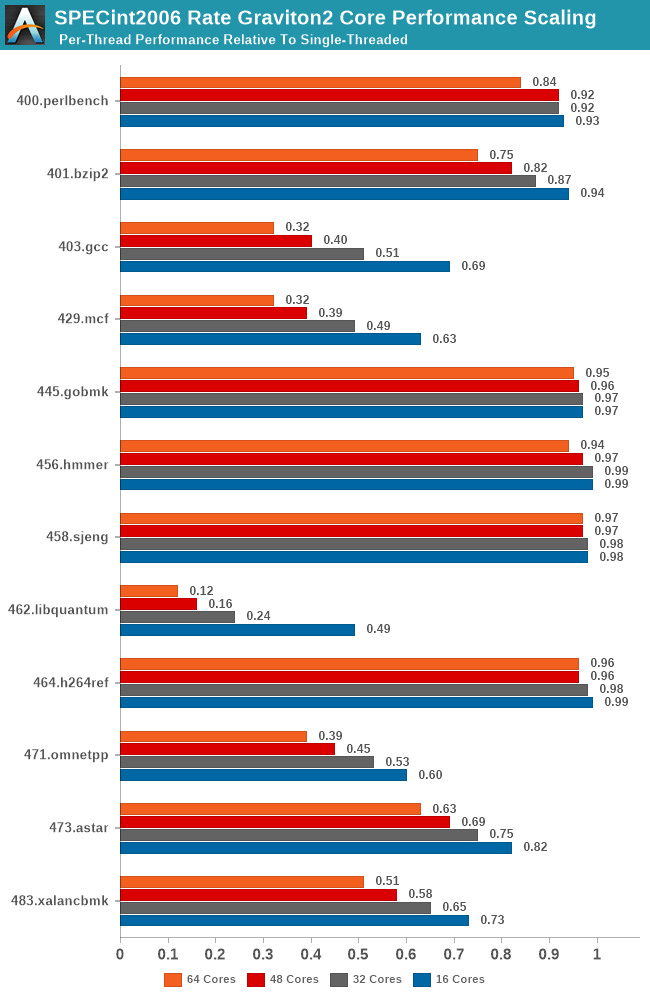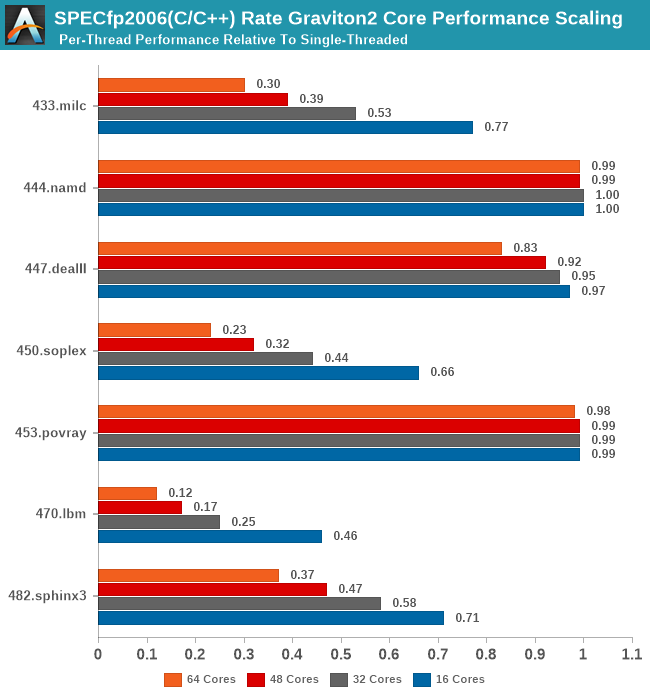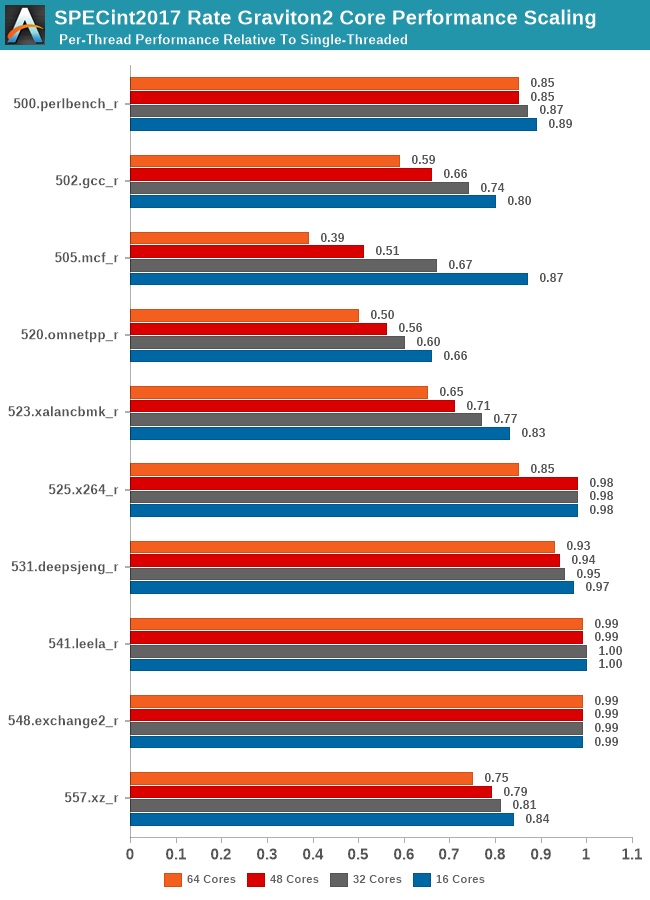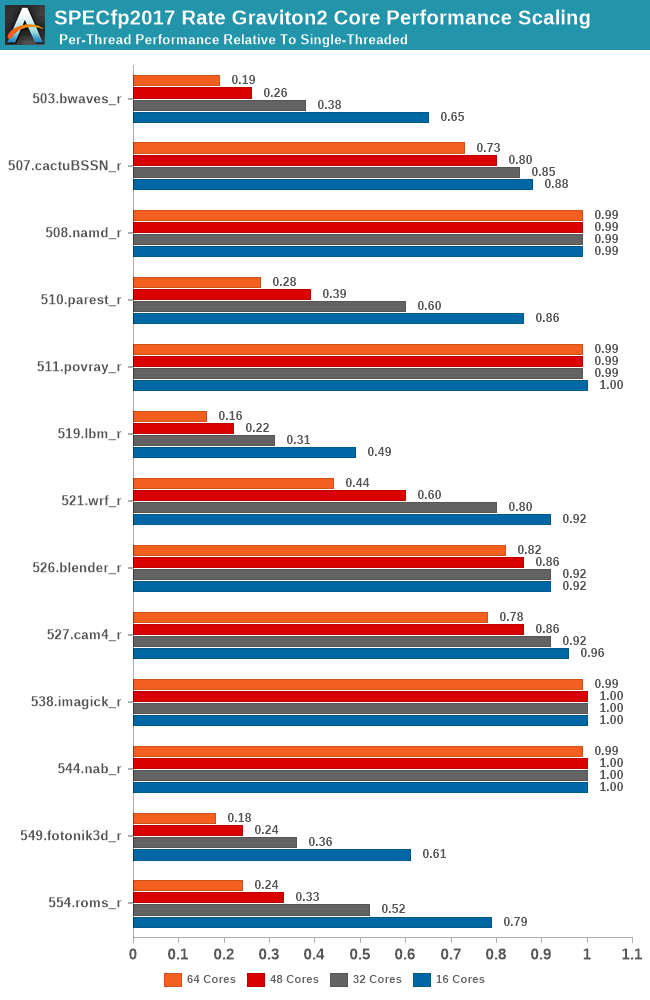Amazon's Arm-based Graviton2 Against AMD and Intel: Comparing Cloud Compute
by Andrei Frumusanu on March 10, 2020 8:30 AM EST- Posted in
- Servers
- CPUs
- Cloud Computing
- Amazon
- AWS
- Neoverse N1
- Graviton2
SPEC - Multi-Core Performance Scaling
I did mention the L3 cache of the Graviton2 was shared amongst all its cores, and we also discovered how only 8-16 cores were able to saturate the memory controllers of the system. To put those aspects into better context, I ran the SPEC suites at rate instance numbers, ranging from 16, 32, 48 and the full 64 cores, and normalised the results relative to the per-thread performance showcased in the rate-1 single-threaded runs.
What this attempts to showcase is the performance scaling of the full SoC across varying loads of the different workload types. Scaling linearly across cores might be easy for some workloads, but for anything that even remotely has some kind of memory pressure should see greater slowdowns given that all the threads are competing for the shared L3 and DRAM resources.
The testing here for all figures were done on a 16xlarge instance with 64 vCPUs to avoid the possibility of noisy neighbours, and give better reliability in the lower core count results.

As expected, we’re seeing a quite wide range of results here, and it’s also a good showcase of which SPEC workloads are memory and cache intensive and which are not. Workloads such as 445.gobmk and 456.hmmer aren’t surprising in their near linear scaling as they don’t have too much cache pressure, and the Graviton2’s 1MB L2 per core is also more than enough for 464.h264ref.
On the other hand, well known memory intensive workloads such as 462.libquantum absolutely crater in terms of per-thread performance. This memory bandwidth demanding workload is fully saturating the bandwidth of the system early on with very few cores, meaning that performance barely increases the more threads and cores we throw at it. Such a scaling more or less is mimicked in other workloads of varying cache and memory pressure.
The most worrying result though is 403.gcc. Code compilation should have been one of the bigger use-cases for a platform such as Graviton2, but the platform is having issues scaling well with core count, undoubtedly a result of higher cache pressure of the system. In a single-thread scenario in the system a core would have access to 33MB L2+L3, but when having 64 cores doing the same thing at once you’d end up with only 1.5MB per core, assuming things are evenly competitively shared.

In SPECfp2006, again, we see the well-known memory intensive workloads such as 433.milc and 470.lbm crater in their per-thread performance the more threads you throw at the system, while other workloads are able to scale near linearly with cores.

In SPECint2017, we see the workload changes I referred to previously on the single-threaded page. The new gcc and mcf tests are actually scaling better than their 2006 counterparts due to actually reduced memory pressure on the new tests. It does beg the question of which variant of the test is actually more representative of most workloads of these types.

Compared to the int2017 suite, the fp2017 suite scales significantly worse for a larger number of workloads. When Ampere last week talked about its Altra processor, and that it was “designed for integer workloads”, that didn't make too much sense other than in the context that the N1 cores are missing wider SIMD execution units. What does make sense though is that the floating-point suite of SPEC is a lot more memory intensive and SoCs like the Graviton2 don’t fare as well at higher loaded core-counts.
It will be interesting to see where the Arm chip designers are heading to in regards to this general memory bottleneck. If your workload isn’t too memory intensive then scaling up to such huge core counts is an easy way to scale performance as well. On the opposite end of the spectrum on memory hungry workloads, these chips will just be memory starved. Arm had envisioned 64 core Neoverse N1 systems to have 64-128MB of L3 cache, and the CMN-600 scales up to 256MB total in a 128-core system, which seem like more sensible and balanced targets.










96 Comments
View All Comments
notladca - Tuesday, March 10, 2020 - link
I would love to know if the product line has split within Annapurna. In other words whether Graviton2 has, like previous Annapurna SoCs, some interesting support around storage and networking for use in future Nitro. It's possible Amazon has some behind the scenes work going on with CCIX for future machines. For example integrating their Inferentia chip more closely with the SoC.Given the core count, it'd also be interesting to compare ML inference acceleration via fp16 and int8 dot product instructions per core vs use of GPU or Inferentia.
coder543 - Tuesday, March 10, 2020 - link
One small bit of feedback: with that CPU topology chart, the coloration seems a little off. A difference of +/- 1 yields very different shades of red and orange, but the same difference on the green side of the spectrum yields no discernible difference in color? Personally, I think all of the 200 +/- 5 values in the first topology chart should be an almost uniform sea of orange/red. The important thing is the 150 difference in latency, not the +/- 1 latency, and the noise in the colors distracts the reader from the primary distinction. A lower signal to noise ratio.Also: what is the unit? nanoseconds? microseconds? milliseconds? I can’t figure it out, and it’s not labeled as far as I can tell.
Andrei Frumusanu - Tuesday, March 10, 2020 - link
Nanoseconds, I'll add a remark.sing_electric - Tuesday, March 10, 2020 - link
My tin hat is telling me to be suspicious of Amazon's pricing here. When shopping for cloud computing, perf/$ becomes VERY alluring, but I have to wonder if Amazon is willing to let its Gravitron servers be a "loss leader," artificially lowering prices to get market share until Arm on server is well-established - before then raising prices to something closer to a economically sustainable number.Andrei Frumusanu - Tuesday, March 10, 2020 - link
Vertical integration is powerful. Amazon can share profits and margins division wide, not having to pay overhead to AMD/Intel.sing_electric - Tuesday, March 10, 2020 - link
True, but then Amazon has to pay for the ARM license and 100% of the development/production costs. I would be very surprised if they managed to *make money* on the 1st couple Graviton generations (especially if you factor in having to buy Annapurna), since you'd need to say "of the $X generated by Graviton metal, $Y would have been spent on EC2 anyways, meaning $Z is our actual gain," and that's... probably too much to ask at this stage.rahvin - Tuesday, March 10, 2020 - link
The costs you mention are nothing compared to what they pay right now with Intel or AMD with they 50% margins on top of the actual cost. IMO this initiative was born out of Intel's price increases from 2010 to now. By vertically integrating they have full control over the price structure and they have very good data on what kind of workloads are running so they can tailor the design.IMO it was just a question of time until Amazon tried to vertically integrate this like they've done with shipping and lots of other stuff. Bezos is following the Robber Barron growth model.
dotjaz - Wednesday, March 11, 2020 - link
Huh? AMD has a gross margin of 40%, true. But keep in mind AWS has a operating margin of 30%, that mean AWS has a even higher gross margin than AMD, comparable to AMD's server department.Do you know what that means? For $1 of expenditure in to chip manufacturing, AWS expects to earn as much as AMD does. And since AWS don't have the volume as far as chip goes, their gross margin for chip investment will be lower, therefore not worth the investment if the decision is purely financial.
But yes, the other point stands, AWS have better control of costing (with more leverage as well) and performance.
Wilco1 - Wednesday, March 11, 2020 - link
For every $1 worth of silicon you could pay AMD $1.50, pay Intel $2 or pay TSMC $1 plus $0.20 internal development costs. Which works out best you think?extide - Friday, March 13, 2020 - link
It's not that simple. AMD and Intel can spread those development costs over vastly more processors. I mean we'll never know how it truly breaks down -- but I'd imagine Amazon has figure this all out and this will be pretty profitable for them.